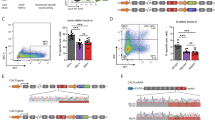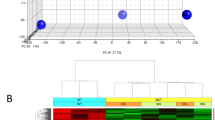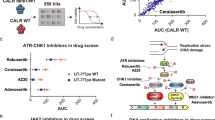Abstract
Cancer is driven by somatic mutations that provide a fitness advantage. While targeted therapies often focus on the mutated gene or its direct downstream effectors, imbalances brought on by cell-state alterations may also confer unique vulnerabilities. In myeloproliferative neoplasms (MPN), somatic mutations in the calreticulin (CALR) gene are disease-initiating through aberrant binding of mutant CALR to the thrombopoietin receptor MPL and ligand-independent activation of JAK-STAT signaling. Despite these mechanistic insights into the pathogenesis of CALR-mutant MPN, there are currently no mutant CALR-selective therapies available. Here, we identified differential upregulation of unfolded proteins, the proteasome and the ER stress response in CALR-mutant hematopoietic stem cells (HSCs) and megakaryocyte progenitors. We further found that combined pharmacological inhibition of the proteasome and IRE1-XBP1 axis of the ER stress response preferentially targets Calr-mutated HSCs and megakaryocytic-lineage cells over wild-type cells in vivo, resulting in an amelioration of the MPN phenotype. In serial transplantation assays following combined proteasome/IRE1 inhibition for six weeks, we did not find preferential depletion of Calr-mutant long-term HSCs. Together, these findings leverage altered proteostasis in Calr-mutant MPN to identify combinatorial dependencies that may be targeted for therapeutic benefit and suggest that eradicating disease-propagating Calr-mutant LT-HSCs may require more sustained treatment.

This is a preview of subscription content, access via your institution
Access options
Subscribe to this journal
Receive 12 print issues and online access
$259.00 per year
only $21.58 per issue
Buy this article
- Purchase on Springer Link
- Instant access to full article PDF
Prices may be subject to local taxes which are calculated during checkout






Similar content being viewed by others
Data availability
All data generated or analyzed during this study are either included in this published paper [and its supplementary information files] or will be made available upon request.
The long-term hematopoietic stem cell RNA-sequencing data set generated and analyzed during the current study will be made available (GEO accession number in generation). The Genotype of Transcriptome dataset analyzed during the current study is available in the GEO repository, accession ID: GSE117826. Databank URL:
The whole-genome CRISPR depletion screen dataset analyzed during the current study is available in the GEO repository, accession ID: GSE203456
Token: klipmmwivtsnvyn.
References
Mead AJ, Mullally A. Myeloproliferative neoplasm stem cells. Blood. 2017;129:1607–16.
Klampfl T, Gisslinger H, Harutyunyan AS, Nivarthi H, Rumi E, Milosevic JD, et al. Somatic Mutations of Calreticulin in Myeloproliferative Neoplasms. N Engl J Med. 2013;369:2379–90.
Nangalia J, Massie CE, Baxter EJ, Nice FL, Gundem G, Wedge DC, et al. Somatic CALR Mutations in Myeloproliferative Neoplasms with Nonmutated JAK2. N Engl J Med. 2013;369:2391–405.
Grinfeld J, Nangalia J, Baxter EJ, Wedge DC, Angelopoulos N, Cantrill R, et al. Classification and Personalized Prognosis in Myeloproliferative Neoplasms. N Engl J Med. 2018;379:1416–30.
Elf S, Abdelfattah NS, Chen E, Perales-Paton J, Rosen EA, Ko A, et al. Mutant Calreticulin Requires Both Its Mutant C-terminus and the Thrombopoietin Receptor for Oncogenic Transformation. Cancer Disco. 2016;6:368–81.
Marty C, Pecquet C, Nivarthi H, El-Khoury M, Chachoua I, Tulliez M, et al. Calreticulin mutants in mice induce an MPL-dependent thrombocytosis with frequent progression to myelofibrosis. Blood. 2016;127:1317–24.
Li J, Prins D, Park HJ, Grinfeld J, Gonzalez-Arias C, Loughran S, et al. Mutant calreticulin knock-in mice develop thrombocytosis and myelofibrosis without a stem cell self-renewal advantage. Blood. 2017;131:649–61.
Pietra D, Rumi E, Ferretti VV, Buduo CAD, Milanesi C, Cavalloni C, et al. Differential clinical effects of different mutation subtypes in CALR-mutant myeloproliferative neoplasms. Leukemia. 2016;30:431–8.
Ibarra J, Elbanna YA, Kurylowicz K, Ciboddo M, Greenbaum HS, Arellano NS, et al. Type 1 but not type 2 calreticulin mutations activate the IRE1a/XBP1 pathway of the unfolded protein response to drive myeloproliferative neoplasmsType 1 CALR mutations activate IRE1a/XBP1 to drive MPNs. Blood Cancer Discov. 2022;3:298–315.
Yoshida H, Matsui T, Yamamoto A, Okada T, Mori K. XBP1 mRNA Is Induced by ATF6 and Spliced by IRE1 in Response to ER Stress to Produce a Highly Active Transcription Factor. Cell. 2001;107:881–91.
Shen X, Ellis RE, Lee K, Liu C-Y, Yang K, Solomon A, et al. Complementary Signaling Pathways Regulate the Unfolded Protein Response and Are Required for C. elegans Development. Cell. 2001;107:893–903.
Calfon M, Zeng H, Urano F, Till JH, Hubbard SR, Harding HP, et al. IRE1 couples endoplasmic reticulum load to secretory capacity by processing the XBP-1 mRNA. Nature. 2002;415:92–6.
Nam AS, Kim K-T, Chaligne R, Izzo F, Ang C, Taylor J, et al. Somatic mutations and cell identity linked by Genotyping of Transcriptomes. Nature. 2019;571:355–60.
Walter P, Ron D. The Unfolded Protein Response: From Stress Pathway to Homeostatic Regulation. Science. 2011;334:1081–6.
Hetz C, Papa FR. The Unfolded Protein Response and Cell Fate Control. Mol Cell. 2018;69:169–81.
Harding HP, Calfon M, Urano F, Novoa I, Ron D. Transcriptional and translational control in the mammalian unfolded protein response. Annu Rev Cell Dev Bi. 2002;18:575–99.
Szegezdi E, Logue SE, Gorman AM, Samali A. Mediators of endoplasmic reticulum stress‐induced apoptosis. Embo Rep. 2006;7:880–5.
Sano R, Reed JC. ER stress-induced cell death mechanisms. Biochimica Et Biophysica Acta Bba - Mol Cell Res. 2013;1833:3460–70.
Myers SA, Rhoads A, Cocco AR, Peckner R, Haber AL, Schweitzer LD, et al. Streamlined Protocol for Deep Proteomic Profiling of FAC-sorted Cells and Its Application to Freshly Isolated Murine Immune Cells*. Mol Cell Proteom. 2019;18:995–1009.
Park S-M, Kang T-I, So J-S. Roles of XBP1s in Transcriptional Regulation of Target. Genes Biomed. 2021;9:791.
Han L, Schubert C, Köhler J, Schemionek M, Isfort S, Brümmendorf TH, et al. Calreticulin-mutant proteins induce megakaryocytic signaling to transform hematopoietic cells and undergo accelerated degradation and Golgi-mediated secretion. J Hematol Oncol. 2016;9:45.
Jutzi JS, Marneth AE, Ciboddo M, Guerra-Moreno A, Jiménez-Santos MJ, Kosmidou A et al. Whole-genome CRISPR screening identifies N-glycosylation as a genetic and therapeutic vulnerability in CALR-mutant MPN. Blood 2022. https://doi.org/10.1182/blood.2022015629.
Bhatt S, Pioso MS, Olesinski EA, Yilma B, Ryan JA, Mashaka T, et al. Reduced Mitochondrial Apoptotic Priming Drives Resistance to BH3 Mimetics in Acute Myeloid Leukemia. Cancer Cell. 2020;38:872–90.e6
Chen MZ, Moily NS, Bridgford JL, Wood RJ, Radwan M, Smith TA, et al. A thiol probe for measuring unfolded protein load and proteostasis in cells. Nat Commun. 2017;8:474.
Jutzi JS, Kleppe M, Dias J, Staehle HF, Shank K, Teruya-Feldstein J, et al. LSD1 Inhibition Prolongs Survival in Mouse Models of MPN by Selectively Targeting the Disease Clone. Hemasphere. 2018;2:e54.
Lau WWY, Hannah R, Green AR, Göttgens B. The JAK-STAT signaling pathway is differentially activated in CALR-positive compared with JAK2V617F-positive ET patients. Blood. 2015;125:1679–81.
Prins D, Arias CG, Klampfl T, Grinfeld J, Green AR. Mutant Calreticulin in the Myeloproliferative Neoplasms. Hemasphere. 2020;4:e333.
Lee A-H, Iwakoshi NN, Glimcher LH. XBP-1 Regulates a Subset of Endoplasmic Reticulum Resident Chaperone Genes in the Unfolded Protein Response. Mol Cell Biol. 2003;23:7448–59.
Yamamoto K, Suzuki N, Wada T, Okada T, Yoshida H, Kaufman RJ, et al. Human HRD1 Promoter Carries a Functional Unfolded Protein Response Element to Which XBP1 but not ATF6 Directly Binds. J Biochem. 2008;144:477–86.
Yoshida H, Matsui T, Hosokawa N, Kaufman RJ, Nagata K, Mori K. A Time-Dependent Phase Shift in the Mammalian Unfolded Protein Response. Dev Cell. 2003;4:265–71.
Byrd AE, Brewer JW. Intricately Regulated: A Cellular Toolbox for Fine-Tuning XBP1 Expression and Activity. Cells. 2012;1:738–53.
Sheng X, Nenseth HZ, Qu S, Kuzu OF, Frahnow T, Simon L, et al. IRE1α-XBP1s pathway promotes prostate cancer by activating c-MYC signaling. Nat Commun. 2019;10:323.
Zhao N, Cao J, Xu L, Tang Q, Dobrolecki LE, Lv X, et al. Pharmacological targeting of MYC-regulated IRE1/XBP1 pathway suppresses MYC-driven breast cancer. J Clin Investig. 2018;128:1283–99.
Pecquet C, Chachoua I, Roy A, Balligand T, Vertenoeil G, Leroy E, et al. Calreticulin mutants as oncogenic rogue chaperones for TpoR and traffic-defective pathogenic TpoR mutants. Blood. 2019;133:2669–81.
Balligand T, Achouri Y, Pecquet C, Gaudray G, Colau D, Hug E, et al. Knock-in of murine Calr del52 induces essential thrombocythemia with slow-rising dominance in mice and reveals key role of Calr exon 9 in cardiac development. Leukemia. 2020;34:510–21.
Barosi G, Gattoni E, Guglielmelli P, Campanelli R, Facchetti F, Fisogni S, et al. Phase I/II study of single‐agent bortezomib for the treatment of patients with myelofibrosis. Clinical and biological effects of proteasome inhibition. Am J Hematol. 2010;85:616–9.
Wagner-Ballon O, Pisani DF, Gastinne T, Tulliez M, Chaligné R, Lacout C, et al. Proteasome inhibitor bortezomib impairs both myelofibrosis and osteosclerosis induced by high thrombopoietin levels in mice. Blood. 2007;110:345–53.
Zheng S, Wang W, Aldahdooh J, Malyutina A, Shadbahr T, Tanoli Z et al. SynergyFinder Plus: Toward Better Interpretation and Annotation of Drug Combination Screening Datasets. Genom Proteom Bioinform. 2022. https://doi.org/10.1016/j.gpb.2022.01.004.
Acknowledgements
The authors thank Professor Anthony Green (University of Cambridge, UK) for sharing mutant Calr knockin mice. The Sysmex veterinary hematology analyzer instrument is a generous loan from Sysmex. We thank Dr. Martha Sola-Visner and her lab members Michael Zhang and Dr. Patricia Davenport (Boston Children’s Hospital) for kindly sharing Sysmex equipment for complete blood counts. The authors appreciate the technical support by the BCH Flow lab, namely by Mahnaz Paktinat and Ronald Mathieu as well as by the BWH CCM veterinary staff. JSJ acknowledges funding from the German Research Foundation (DFG, JU 3104/2-1). JSJ is a Special Fellow of The Leukemia & Lymphoma Society (3415-22). AEM receives funding from the US Department of Defense (Horizon Award W81XWH-20-1-0904). BJ is a recipient of the Mildred-Scheel Scholarship from German Cancer Aid (70114570). This work was supported in part by grants from the National Cancer Institute (NCI) Clinical Proteomic Tumor Analysis Consortium grants NIH/NCI U24-CA210986 and NIH/NCI U01 CA214125 (to SAC). YH acknowledges funding support from the Australian Research Council FT210100271. ASN is supported by the Burroughs Wellcome Fund Career Award for Medical Scientists, the National Institutes of Health Director’s Early Independence Award (DP5 OD029619-01), and the Starr Cancer Consortium (I15-0026). AM acknowledges funding from NIH NHLBI (R01HL131835), the Gabrielle’s Angel Foundation for Cancer Research (GAFCR), and the Starr Cancer Consortium (I15-0026). AM is a Scholar of The Leukemia & Lymphoma Society.
Author information
Authors and Affiliations
Contributions
JSJ was responsible for designing the project, conducting the research, extracting and analyzing data, interpreting results, and writing the paper. AEM was responsible for designing the project, conducting the research, extracting and analyzing data, interpreting results, and editing the paper. MJJS was responsible for extracting and analyzing data and interpreting results. JH was responsible for conducting the research and analyzing data. AGM was responsible for conducting the research, extracting and analyzing data, and interpreting results. BR was responsible for conducting the research and analyzing data. SB was responsible for conducting the research and analyzing data. SAM was responsible for conducting the research and analyzing data. SAC was responsible for designing research and supervision. YH was responsible for providing essential material and method support. PvG was responsible for designing research, supervision, and interpreting of results and editing the paper. SEE was responsible for conducting the research extracting and analyzing data, and interpreting results. FAS was responsible for designing research, supervision, and interpreting of results. AN was responsible for designing research, extracting and analyzing data, and interpreting of results and editing the paper. AM was responsible for designing the project, supervision of the project, interpreting results, and writing the paper.
Corresponding author
Ethics declarations
Competing interests
SAC is a member of the scientific advisory boards of Kymera, PTM BioLabs, Seer and PrognomIQ. AM receives research funding from Relay Therapeutics. AM has consulted for Janssen, PharmaEssentia, Actuate, Constellation, Aclaris Cellarity, Morphic, BioMarin, Protagonist and Incyte. AM has received research funding from Janssen and Actuate Therapeutics.
Additional information
Publisher’s note Springer Nature remains neutral with regard to jurisdictional claims in published maps and institutional affiliations.
Supplementary information
Rights and permissions
Springer Nature or its licensor (e.g. a society or other partner) holds exclusive rights to this article under a publishing agreement with the author(s) or other rightsholder(s); author self-archiving of the accepted manuscript version of this article is solely governed by the terms of such publishing agreement and applicable law.
About this article
Cite this article
Jutzi, J.S., Marneth, A.E., Jiménez-Santos, M.J. et al. CALR-mutated cells are vulnerable to combined inhibition of the proteasome and the endoplasmic reticulum stress response. Leukemia 37, 359–369 (2023). https://doi.org/10.1038/s41375-022-01781-0
Received:
Revised:
Accepted:
Published:
Issue Date:
DOI: https://doi.org/10.1038/s41375-022-01781-0



